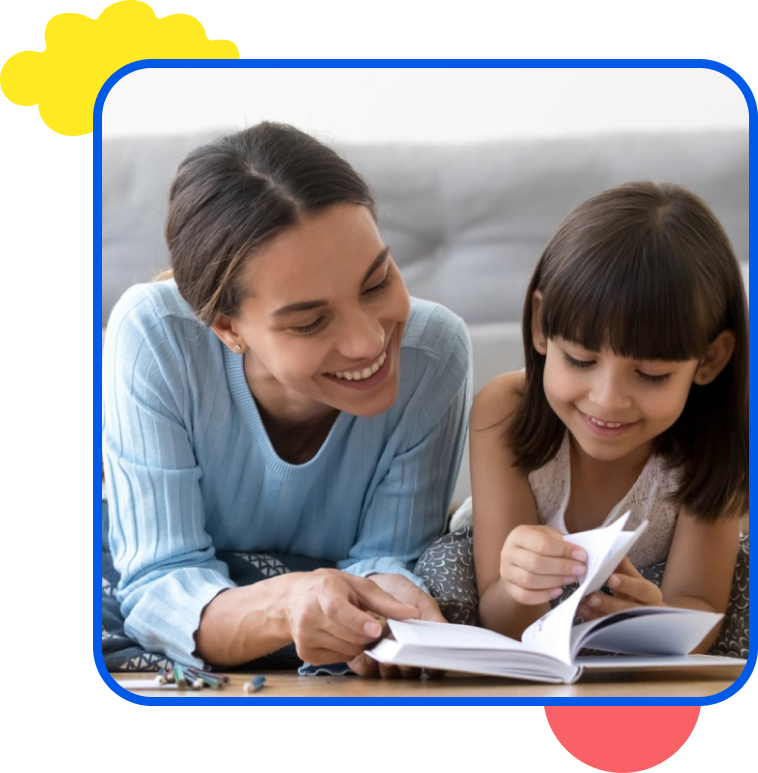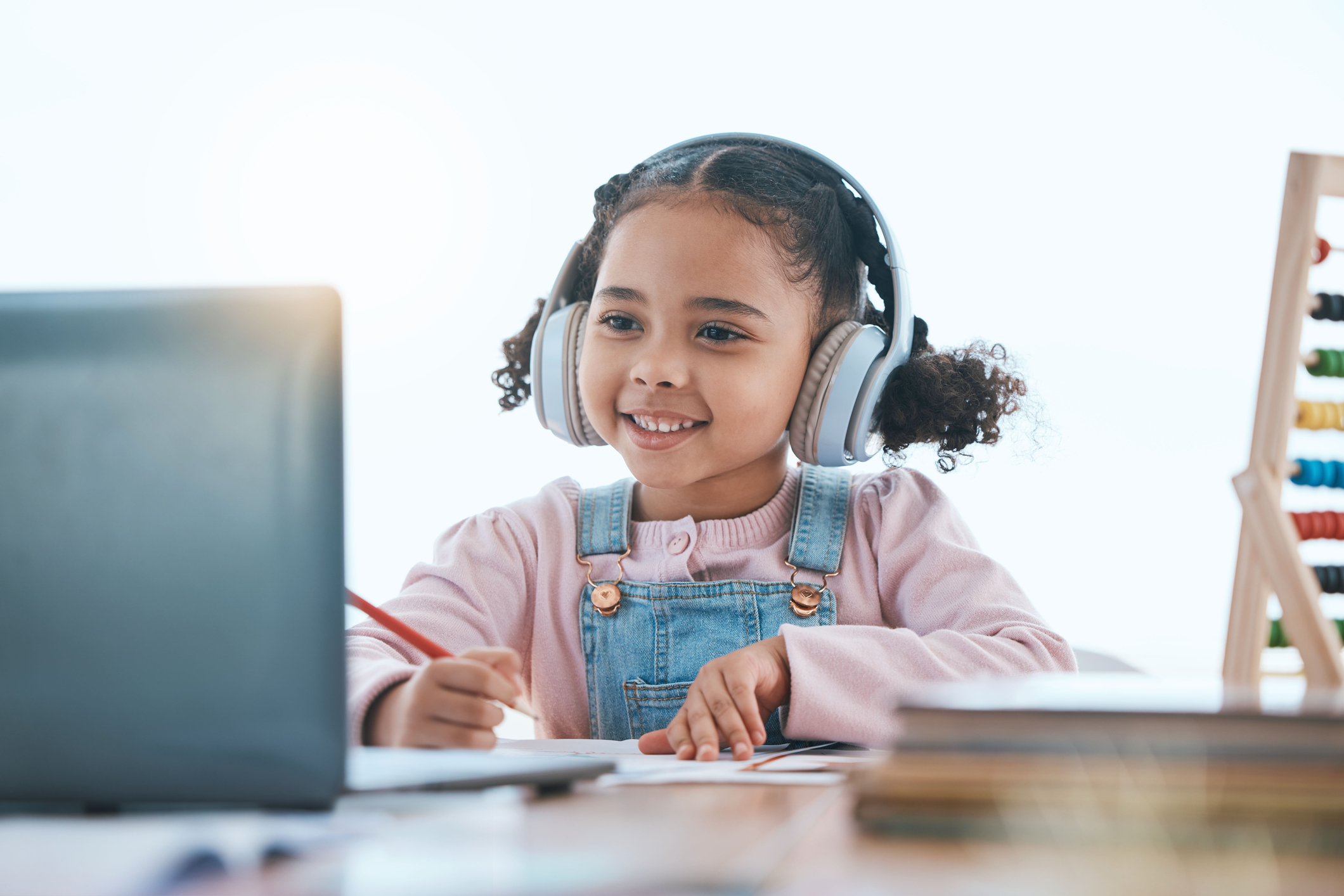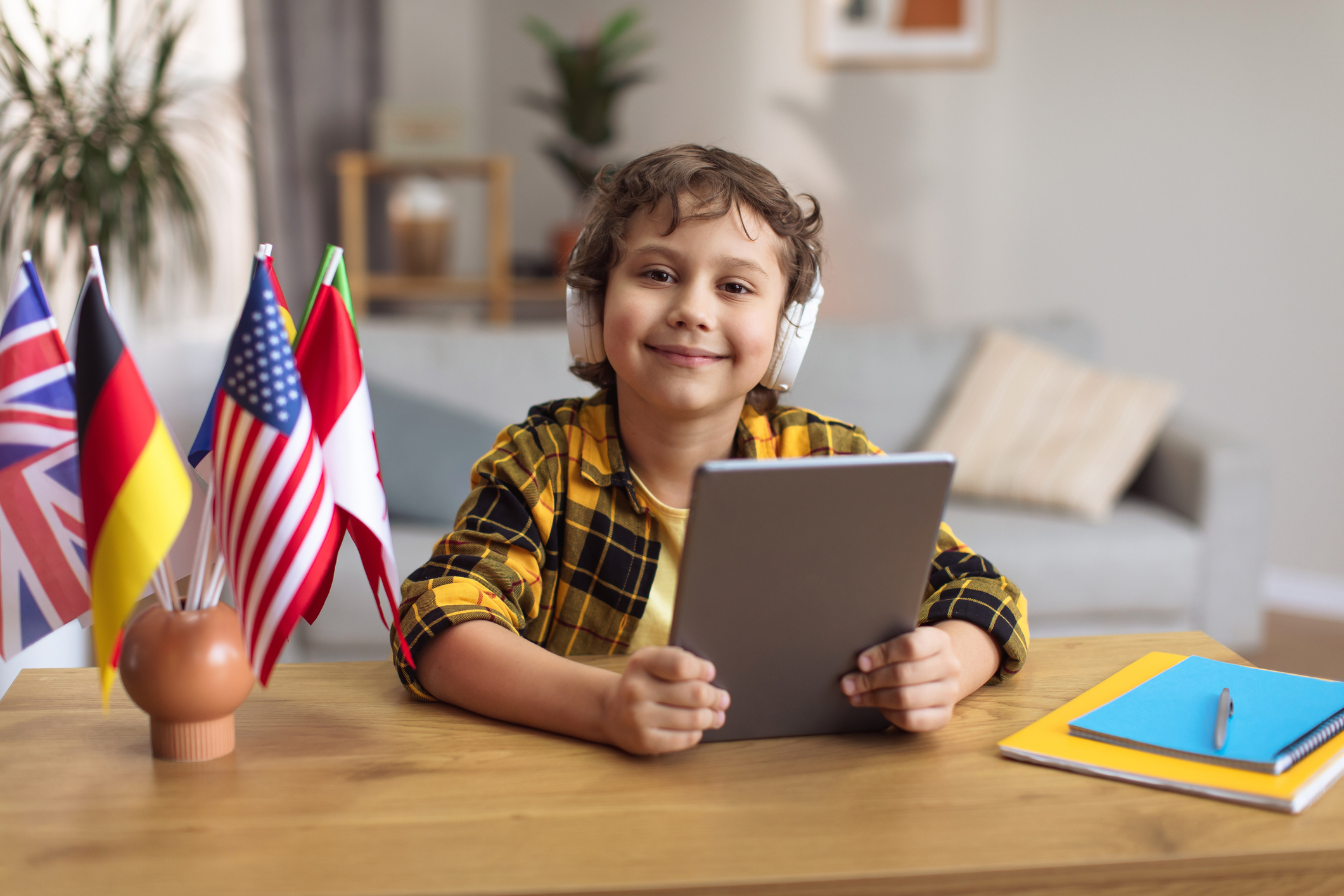Spanish Immersion: Is It Possible at Home?



Are you dreaming of your family speaking Spanish fluently? You can make this dream become a reality with Spanish immersion!
Although, you may be wondering: how can you immerse yourself in Spanish, especially if you don’t live in a Spanish-speaking country? The answer here is not to move across the world! Just by making a few small changes, you can create an immersive environment from the comfort of your own home.
Spanish immersion doesn’t have to be expensive either. While Spanish immersion schools may be the best option out there to encourage language fluency, it’s completely possible to do this from your home and for little to no cost.
Here are some small changes that you can make in your daily lives to start learning Spanish as a family today!
Change 1: Change the settings in your electronic devices
With technology at our fingertips, you have an easy opportunity to pick up some native phrases and immerse yourself and your family in Spanish by switching all of your device’s language to Spanish.
Since we commonly use phones, tablets, the TV, and computer, you will be surprised as to how much vocabulary you will learn from making this switch. As you download new apps, do some research, and communicate with friends and family, you’ll be learning as you’re doing habitual tasks. Changing your electronic devices to Spanish easily boost your skills.
Change 2: Mix up your daily vocabulary
Do you know the Spanish word for every object in your house? Start enhancing your vocabulary with things you talk about every day right under your nose.
You don’t need to put sticky notes on every single object in your own home to learn vocabulary (unless you really want to). However, if you don’t know the word for some objects, it’s a great idea to look it up and write it down. Writing down new words is a memory technique that will help you and your children remember and be able to recall the word later on.
Although big goals are great, it’s best to start small. If you write down the name of every object in your home, you can easily be overwhelmed with new information. It’s best to start with just a few objects (or the objects in one room) at a time to build your vocabulary comfortably, get used to using them in a sentence, and then move on to the next set.
Check out this list of easy Spanish words for kids to get started!
Change 3: Start surfing in Spanish
Where do we search for the majority of information? The internet.
The next time that you are searching for information, tracking down a recipe, shopping for gifts, getting on social media, or even checking world news – try searching in Spanish. By typing keywords into the search bar, you’ll see a variety of search results completely in Spanish. This is a great way to immerse yourself in Spanish as a native speaker would.
Reading recipes or following food guides, you will have a great way for you and your family to get familiar with Spanish in the kitchen. As far as social media goes, start following some Latin celebrities to see how they communicate, give compliments, use slang, and choose hashtags on different topics.
Caution: when following celebrities, pay attention to where they are from. Each Spanish-speaking country has its own dialect. What does this mean? It means that their vocabulary may differ from the vocabulary that you are already learning.
Although different dialects can be great for you to expand your vocabulary, it’s better to focus on one dialect at the beginning of your Spanish immersion. For example, Spanish from Spain is quite different from Spanish spoken in Latin America. In this dialect, you will not only find different vocabulary words, but also a different verb conjugation that is only used in Spain.
If you are not planning to travel to Spain, it may be better to focus on a different dialect for your first one. Staying in one dialect will help you build consistency within your fluency, but in the future, diving into different dialects can really help your Spanish take off to the next level.
Change 4: Create stories and journal
Depending on the age of your children, journaling every day in Spanish can be a great way to enhance their language skills (and your own!). Journaling is a way to express creativity and emotions. It’s also a great way to calm down, relax, and think about your day.
Doing this in Spanish will be a great way to practice reflection, build a train of thought, and practice different sentence constructions. Even if you only start with a few sentences, bullet points, or just a few words, this will encourage more brain function in Spanish.
If your child isn’t old enough to journal, encourage them to draw and create a story about their picture in Spanish to practice their thinking, description skills, and language development.
Change 5: Read in Spanish
Reading stories encourages imagination and builds vocabulary quickly. Books have endless topics, themes, lessons to learn, and teachable moments. From learning about dragons, to cooking your favorite meal, to following sports, the vocabulary possibilities are endless.
Luckily, many popular children’s books and novels are available in Spanish already. You also have the option to find your favorite book properly translated.
You can read your favorite books to your children in Spanish and have them follow along. If you are already familiar with stories, it makes it very easy to understand the vocabulary without having to pause to grab a dictionary.
If you’re interested in reading some of the best children’s books in Spanish, check out this article of the 10 best Spanish books for kids or 15 top-rated bilingual books for kids (in English and Spanish).
Change 6: Write to-do lists in Spanish
This may be challenging at first, especially because thinking of your to-do list might be a stressful task. But practicing your writing skills and your everyday vocabulary will really help you improve your fluency level and create an immersive experience.
By writing a to-do list and talking about what your daily plans are with your family, you realize how many everyday words you may not be familiar with already.
Once you write down a new word, be sure to put it on a flashcard to keep practicing afterward.
Change 7: Learn while you relax with a movie
Want to catch up on the latest TV series, watch a movie with the family, or give your child some screen time?
With the globalization of our world today, you’re likely to find your favorite TV series or movie available in Spanish. However, it’s even better to find a Spanish or Latin program and get exposed to their movie culture while learning the language. On many streaming services, you’ll have the option to search for programs in different languages, but if you can’t find anything you’re interested in – take a look at YouTube!
If you need to find a place to get started, we’ve done some research and have found 7 great movies in Spanish for your whole family and 12 TV shows in Spanish for kids!
Change 8: Use your commute to your advantage
We spend a lot of time each day commuting. Whether it’s driving the kids to school, going to work, driving to the store, taking your child to soccer practice, play dates, a long road trip – we commute for hours and hours every week.
Commuting is the perfect opportunity to immerse yourself in Spanish while driving, taking the bus, or walking to your destination. There are many Spanish audiobooks, podcasts, and radio stations that you can put on to pass the time and learn!
You can listen to a kid-friendly novel, an intriguing podcast, or jam out to some Latin music. This is a great way to pick up vocabulary on the go while accomplishing your daily tasks.
Spotify, Amazon, FM radio, and Apple Music have tons of options for Spanish playlists just waiting for you to listen. Some of these music apps provide you with lyrics while you’re listening. Although you may not be able to enjoy this feature if you’re driving, it’s great for others in the car to use to follow along with the lyrics.
After a while, you’ll be able to sing along to your favorite new songs. If you don’t have the lyrics in front of you, it’s important to listen actively and not passively, so you can pick out keywords and phrases to benefit from the music.
Change 9: Take Spanish language classes online
Constant practice can make all the difference. Reading and listening are great ways to immerse yourself in Spanish, but if you aren’t speaking on a regular basis, you are missing out on a very important skill.
One great way to have active conversations is by taking classes online. There are many different types of classes out there, so it can be a bit hard to make a choice. Especially for children, having outside resources and reinforcement for Spanish immersion can be quite helpful for their bilingual development.
When choosing a class, it’s important to find a native, certified teacher that is well-experienced and can really help your child. With LingoCircle, you can have access to an online bilingual education programs with a curriculum designed to help children reach a higher level of fluency. Our online Spanish classes for kids and tweens (ages 3-15) can help enrich your child’s Spanish proficiency fast!
Most importantly, this program creates a unique classroom experience, connecting bilingual children from around the world. Your child will converse and collaborate with classmates in Spanish all while learning to write and read. You can even try out this unique classroom experience to help immerse your child with a free trial lesson!
Change 10: Check out local events and activities
In many cities, there are groups of Spanish-speaking people who come together for activities, services, and socialization.
To really immerse yourself and your family in Spanish, search in your area for any groups, outdoor activities, book clubs, church services, outdoor groups, tea time, or any classes that are offered in Spanish. A quick Google search will help you find a new world of activities happening in your community or the surrounding area.
If you can’t find any information online, go to your local YMCA or community center and ask if there are any programs that they’re aware of. Chances are, you’ll have luck with finding some local events!
Change 11: Travel abroad
If this is something that works for your family, what’s a better to immerse yourself in Spanish than visiting a Spanish-speaking country?
By visiting a Spanish-speaking country, you’ll be using Spanish in real-time and with native speakers. Not only will you get the opportunity to speak more, but you will also be immersed in the culture at the same time. Consider searching for a type of language exchange program or a Spanish immersion program for the whole family.
But before traveling, making these changes to help you start being more accustomed to Spanish in your own home is a great way to learn at your own pace without any pressure.
Is Spanish immersion possible at home?
As you can see, Spanish immersion is 100% possible from inside the comfort of your own home!
Exposure is the most important element in learning a language and achieving fluency. Even without living in a Spanish-speaking country, making small changes in your daily life can really help you immerse yourself further and reach the next level. Good luck!

As parents, we all want what’s best for our children. We want them to thrive, succeed, and be prepared for the future. One way to give your child a competitive edge in our increasingly globalized world is through bilingual education. But what is bilingual education exactly?
Bilingual education is a means of instruction in two languages at the same time using a specialized school curriculum. Still, bilingual education is about more than just learning two languages.
There’s also more than one way to teach bilingual education. The most common methods include dual language programs, transitional bilingual education, and language maintenance programs.
In this blog post, we’ll go over the pros and cons of bilingual education as well as what types of programs exist. We’ll also provide guidance for parents who want to raise a bilingual child.
Let’s begin!
What Is Bilingual Education?
Bilingual education is an educational approach that uses two languages as the medium of instruction. The goal is to help students become proficient in both languages while also mastering academic content.
While this approach may sound new to some, it has actually been around for centuries, dating back to ancient civilizations that recognized the importance of learning multiple languages.
Over time, bilingual education has evolved, with a focus on meeting the needs of diverse populations, such as immigrants and indigenous communities. Its purpose has remained the same, though: to provide students with a high-quality education that prepares them for success in a multilingual and multicultural world.
In today’s world, the importance of bilingual education cannot be overstated. With globalization and the increasing interconnectedness of cultures, bilingualism is becoming more valuable in various fields, from business to diplomacy.
Types of Bilingual Education Programs
Bilingual education is typically offered by a specialized academic institution equipped to instruct various subjects in two or more languages. These types of programs are structured in a way where they split the teaching in the two languages throughout the day.
There are several types of bilingual education programs available, each with its unique approach and benefits. Here are a few of the most common types:
Dual Language Immersion
A dual language education program teaches students both languages simultaneously, to achieve bilingualism and biliteracy. In a typical dual language program, students spend half their day learning in one language (e.g., English) and the other half in another (e.g., Spanish). This approach has been shown to promote not only language development but also academic achievement and cross-cultural understanding.
Transitional Bilingual Education
Also known as early-exit bilingual education, transitional bilingual education programs help non-native speakers of English transition to English-only classrooms as quickly as possible. In a transitional bilingual education program, students receive instruction in their native language for a limited amount of time (usually one to three years) while also receiving instruction in English. The goal is to help students develop English proficiency while maintaining their native language skills.
Maintenance Bilingual Education
Also known as late-exit bilingual education, maintenance bilingual education programs help students maintain their native language skills while also developing English proficiency. In a maintenance bilingual education program, students receive instruction in both languages for an extended period (usually five to seven years or more). The goal is to ensure that students become truly bilingual and biliterate, with strong skills in their native language and English.
Each type of bilingual education program has its unique strengths and benefits, and the choice of program will depend on a variety of factors, including the needs of the student, the goals of the program, and the resources available. As a parent, it’s essential to research the options available and choose the one that best meets your child’s needs.
Overcoming Obstacles: Finding Bilingual Education Programs Near You
Finding a school that offers one of the bilingual programs listed above is one of the easiest ways to create a consistent bilingual environment for your child. However, finding a bilingual school may be a bit difficult, depending on where you live.
Another way to give your child a bilingual education is by speaking in a minority language at home, homeschooling with an age-appropriate curriculum in the minority language, watching educational movies, having external bilingual classes to encourage further interaction, and so on.
This at-home approach requires a blend of face-to-face school and homeschooling due to the level of curriculum needed. Although this may be a more rigorous route, it is still a very effective way to raise a bilingual child.
Either way, there are pros and cons to bilingual programs.
Pros of Bilingual Education
1. Improved brain functioning and memory
Some scientists believe that learning two or more languages improves and strengthens various parts of the brain. Adopting multiple languages allows your brain to recognize patterns quickly and draw connections. This improves your mental state and learning capability in multiple ways. As the brain strengthens, thanks to a foreign language, it gets stronger overall.
Think of your brain as a muscle. If you run, your legs get stronger, and you get faster. As a result, you are overall in better shape; your breathing improves, your ability to perform cardio improves, your abdominals strengthen, etc. It’s like a domino effect — each muscle has an impact on the next. This is true with the muscles and capabilities of your brain as well.
2. Better career opportunities
As the career world is increasingly more competitive, the ability to speak multiple languages will be a great advantage when looking for a job.
Speaking multiple languages and having the ability to perform your job in two or more languages can dramatically improve your chances of landing a job in the future.
Especially if your child could be interested in working for an international firm, a second language may even be required. Not only can a foreign language be valuable for landing a job, but it can also be beneficial to seeing a salary increase.
3. It creates an opportunity for early diversity
Children are not concerned with societal issues like adults are. The average child is most concerned with making friends, playing games, and having fun. Exposure to foreign languages and cultures means that children will be aware that more than one way of life exists.
Because of this, children who speak multiple languages have an easier opportunity to celebrate and enjoy cultural differences instead of shying away from them. This is an attitude that they will learn to embrace throughout their lives.
4. Easier to participate in exchange programs
If your child attends a bilingual school, chances are there will be opportunities to study abroad and participate in an exchange program. Even at a monolingual school, public or private, there may also be opportunities for a foreign exchange program, but the spots for the trip are generally limited.
In bigger schools, there are only a certain number of places, but many interested children. When it comes down to it, the details matter. Speaking a second language will be an advantage over the rest of the crowd.
Many undergraduate courses are only taught in one language at the university level. By choosing to study abroad in a country where you speak the native language, your child will be eligible for scholarships and an authentic experience in the host country.
If you ever want to prepare your child for the opportunity to study abroad, whether in a small group, at the high school level, or the university level, bilingual education is a great way to start.
5. Beneficial for your travels
Being bilingual is a huge advantage when it comes to traveling. If you go to a place where you speak the native language, the locals will generally be a bit more friendly.
By speaking the local language, you already show interest in their culture, so the people automatically feel appreciated and more understood.
It’s an exciting time to chat with locals about their favorite places to visit in their country, where to find the best food, the coolest local events, and advice for what not to do while you’re visiting.
6. It’s easier for a child to learn a second language
Learning one foreign language can be a difficult task, but learning two or more languages simultaneously can be even more difficult. However, children’s brains are at their peak capacity for learning and develop the quickest when they are young. Exposure to a foreign language at an early stage in life will help children absorb complex information more easily.
While adults learning a second language may feel pressured to speak perfectly or feel embarrassed due to accents and making mistakes, children are the opposite. When children learn any language, they will make mistakes and easily learn from them.
Children generally feel less pressure to perform when learning a second language and do not experience the same type of embarrassment when making a mistake.
7. Learning one new language makes it easier to learn more
Once children begin learning a second language, the language development part of their brain strengthens.
Their brain can recognize patterns in more than one way. Sentence structures, vocabulary, subject-verb agreement, etc., are just a few patterns that children will have to pick up on to learn a second language.
If your child wants to learn a third language in the future, starting with a second language will make this a faster process. Once their brain has adapted to this type of learning, it makes it much easier to go through the process again.
Cons of Bilingual Education
1. Learning specific content can be extremely difficult
Although childhood is the best time for younger children to learn a new language, they can experience second-language difficulties starting off.
When things are new, they are especially difficult. New concepts in a new language can bring stress to young students who just want to communicate with their friends, teachers, and peers.
2. Education in a second language can be inconsistent
If you live in an area that has a school offering bilingual education, chances are that that school has an age limit.
Some bilingual schools are for kindergarten, elementary, and middle school but do not have a high school program. And on the reverse side, some schools only offer bilingual programs to high schoolers.
As a result, children may lose some of their foreign language skills. Although bilingual programs can be a great advantage, if your child never uses their second language after finishing a certain school level, they might forget it.
3. A bilingual education is not cheap
Foreign language programs usually are not the cheapest form of education available.
Due to budget cuts, arts and language programs are disappearing across the country. Many schools have to focus on a monolingual curriculum unless the state mandates a second language.
On top of that, any extracurricular language learning activities will most likely come at some expense. Although the benefits of bilingual education make it worth it in the end, it’s important to consider the costs at the beginning.
4. There may be a lack of qualified teachers and assistants
For a bilingual classroom to succeed, it has to provide children with quality exposure to the target language. High quality of exposure can usually only be found in teachers and teaching assistants who are fully fluent in both languages and have adequate teaching experience.
Although it could be an excellent opportunity for a non-fluent teacher or teaching assistant to improve their language skills, it would not necessarily be a fully immersive experience for the students enrolled in the class. The demand for quality teachers around the nation is always high, and finding quality teachers at a monolingual school is difficult enough.
5. Bilingual education can shift a student’s focus
In standard bilingual classrooms, language learning is split roughly 50/50 throughout the day. If a child has trouble learning and using their second language, they can fall behind in other subjects or lose interest in learning the language.
Although this isn’t too common, the only way to improve the minority language is through practice. More practice requires more time focusing on the language and less time focusing on other extracurricular activities throughout the day like art, music, sports, workshop, etc.
If a child feels like they are missing out on “fun” activities throughout the day, they might have a shift in their focus. They may focus negatively on what they are missing out on instead of on what they can gain with more practice.
6. It prevents student involvement in local culture
If a young child is learning two cultures and languages at the same time, they may have a hard time “fitting in” with people who don’t have the same cultural background.
Of course, making friends in class will be easy. Still, there may be a culture gap with monolingual children simply because they have different routines, communication styles, and ways of processing information. This is a unique extreme but can be an isolating situation for children who are adjusting to people who only have one language and one culture.
7. It comes with preconceived ideas
Bilingualism and learning about other cultures can be associated with a touchy subject: immigration. Some communities have a negative view of the structure of bilingual schools. Some see it as a way that immigrants can avoid adapting to the national language and culture.
This is undoubtedly a challenge that shouldn’t heavily impact your decision to enroll your child in a bilingual education program. There is no way to please everyone in any circumstance, and bilingual education, although highly beneficial, is no different.
Final Thoughts: Why Bilingual Education Is Important
For the next generation, speaking multiple languages will be a highly sought-after skill and may even be considered more of a standard. As learning a language is much easier for children, it makes sense to enroll in a bilingual education program from an early age – just be sure to continue bilingual education efforts outside of and after school.
Want to help your child become bilingual from home? Sign them up for a free trial for an online language class with LingoCircle! We offer dual language programs, elementary school curriculums, and CEFR programs in French, Spanish, English, Chinese, Arabic, and Korean. Certified, native-speaking teachers lead each class for children ages 3-15.

Have you ever met someone who can speak a language fluently, but cannot read or write? Aside from children who haven’t yet learned literacy skills, this is still a common issue in our world today. When learning a second language, a lot of people focus on only the speaking and understanding aspect. Well, what about the reading?
Especially if your second language has a different alphabet and writing system, it’s important to start learning this from a young age. Being able to read books, road signs, menus, directions, and even advertisements on the subway are very important to help you fully understand and appreciate your language.
Imagine knowing a second language, visiting a country where it is the native language, and yet still having worries communicating due to the absence of literacy skills. This is an issue that is all too common, but one that can be avoided.
In this article, we will be discussing more about what biliteracy is, how children can achieve it, and the benefits of being biliterate.
What is Biliteracy?

Biliteracy is the ability to proficiently read and write in two languages.
A similar term, not to be confused with biliteracy, is bilingualism. Bilingualism is the ability to fluently speak two languages. A person who is biliterate may not be bilingual, and a person who is bilingual may not always be biliterate. Speaking, listening, and reading and writing are different skills that require a lot of work and therefore, have different terms to describe them.
Both skills are very important to possess and even more important to begin learning at a young age.
When do children start to read and write?
Children typically begin to read and write at a steady pace in school.
This is a gradual process that begins at a young age. In many countries, children will begin their literacy journey in pre-school or kindergarten. However, in some countries, like Poland, Finland, Guatemala and others, children do not begin to work on their literacy skills until 7 years old.
Although children can begin learning the alphabet as early as 2-3 years old, they typically don’t start to put words together and attach meaning to their phonetics until they are about 7-8 years old. However, if your child is 2-3 years old and seems very disinterested and fights to learn – it may be best to wait a few months longer, so they can really focus.
When do children start to read and write in their second language?
Children can learn to read and write in the second language at the same time as their first.
There is no need to wait for a child to become literate in one language to begin the next. Their young minds are flexible and strong enough to learn and separate two languages at the same time and work on their biliteracy skills.
Most children will be able to pick up quickly on sounds and letters to gain progress right away.
As learning to be biliterate in two languages is double the work, they will need some extra support. Although it will require practice, the best time for children to start learning another language is as soon as they can! The more exposure that they have to a language in their early life, the more fluently it will come to them as they grow.
How to Ensure Biliteracy in Children
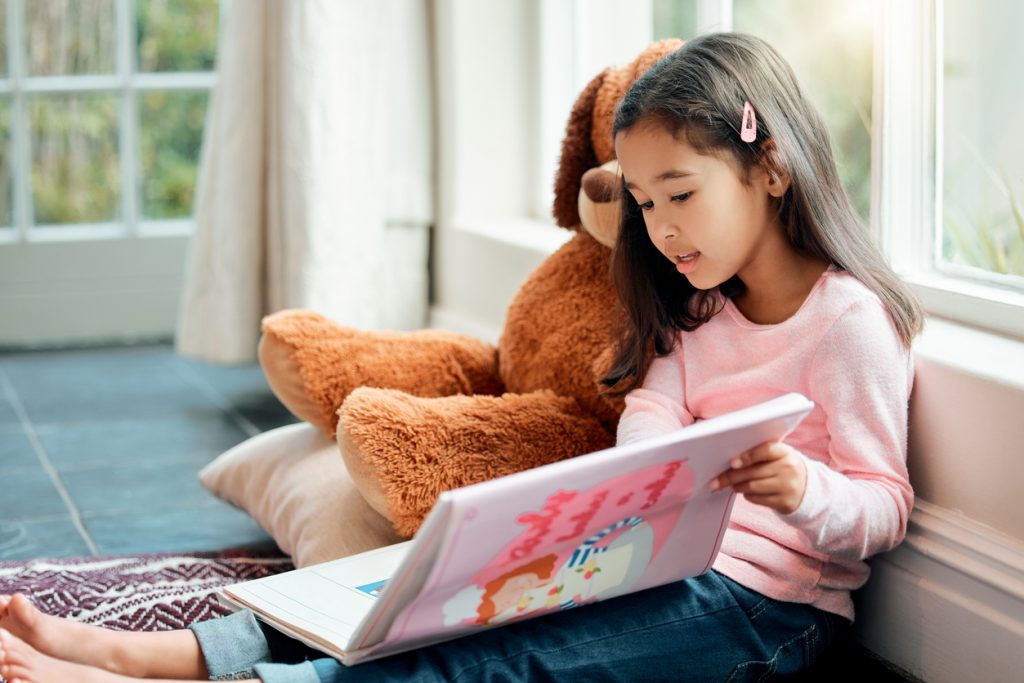
Biliteracy is a learned ability that takes patience and practice. Here are a few tips to ensure that your child will become biliterate:
Learn Letters
The first step to reading is understanding letters and their sounds. This is the basis to phonetics and can be done in two languages at the same time. Letter recognition can be further developed when paired alongside tracing letters, writing letters, and recognizing them independently.
Sometimes recognizing letters can be a guessing game or a slightly passive activity, but by having your child write or trace the letters while they work with the phonetic sound, they will be training their brains to truly follow along.
Having a strong alphabetical recognition in both of their languages will help set their foundation when it comes time for reading.
Bilingual Books
After learning to recognize letters, it’s time to start with words and small books. The best way to encourage biliteracy in children is to build a great bookshelf.
By building a bookshelf, we don’t mean physically. We mean that having books available in both languages that are appropriate for their reading level will do the trick! Having books in both of their languages will give your young one ample opportunity to practice both languages.
Make sure that your child is having equal exposure to languages in their books, or take a look at some bilingual books to maximize their reading time. For example, if you notice that your child prefers their French book about butterflies more than their English book about sea creatures– start looking for the same topics in both languages to peak their interests!
Kids are more excited to learn when they like the subject and can pick out their own books, so make sure that there are plenty of options.
Read Out Loud
When you or your child picks up a book to read – the best thing to do is to read it out loud with them. By reading out loud, children can practice the correct pronunciation, hear how it sounds to read confidently, and also discover any funny character voices along the way.
Children learn how to verbally express themselves by watching and listening. If you read aloud with a lot of emphasis on different characters or even animal noises, it helps them understand the emotion behind words and situations. Furthermore, they can learn to copy the emphasis and read with emotion.
Reading out loud will help your child in more areas than just literacy. By reading aloud, they will quickly strengthen their vocabulary and their sentence structures. As another bonus, reading aloud with your child in both languages encourages family bonding!
Comprehension Skills
After children are able to start recognizing words and letters on their own, it’s important to have books that appropriate for their level.
By getting into the habit of reading books for their level, they will be able to strengthen their currently skill and build on their level and continue progressing. Not only is it important to let your child read and understand, it’s also important to be engaging about what they’ve read. For example, it’s great to ask questions about the story after while it’s happening (or after it’s over) to ensure that they are following along. This question and answer process allows them to reflect on what they’ve read and will help ready their minds for discussion.
For biliterate children, book discussions (or question and answers) are very important to allow them to connect what they read with their speaking skills. This will sharpen the mind in multiple ways!
You can start off by asking what their favorite part of the book is, who the main character is, what animals they’ve noticed, how many trees they saw in their picture book, what do they think will happen next— the possibilities here are endless. The important part is not which questions you ask, it’s that you ask questions in general to encourage a fun discussion that they will enjoy.
Audiobooks and music
Another way to reinforce biliteracy is to use outside sources. Podcasts for kids that function as audiobooks are a great way for children to follow along – especially if an adult can’t be with them when they need help with some words.
Reading and reciting lyrics in music can be a great way for children to practice their reading skills and have fun while doing it. Singing incorporates another part of their brain that can help enhance their comprehension abilities.
Classes
As becoming biliterate can be a bit of a challenge, it’s hard to know where to turn for outside help, especially if your child needs extra attention and outside influences to stay engaged.
Online classes that aid in helping your child learn a second language make all the difference in their learning journey to biliteracy and bilingualism. At ages 3-12, children are at their highest and quickest learning capacity.
LingoCircle is an online language school that understands that this age is critical for children who are becoming biliterate. This online learning hub offers individual and group classes from a native, certified teacher in live virtual classes. With LingoCircle, you have the option to put your best foot forward by signing your child up for French, Spanish, English, Arabic, or Chinese classes.
The Effects of Biliteracy on a Developing Mind
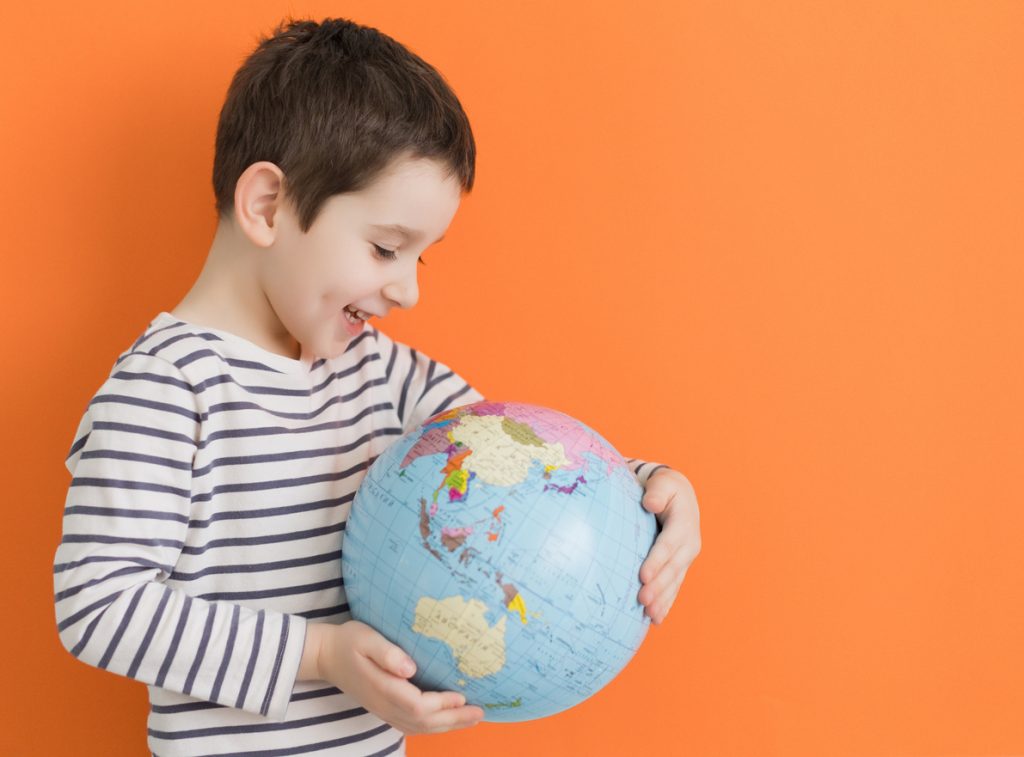
Biliteracy is a great skill that your child will be thankful for throughout their entire life that will provide them with a variety of benefits such as:
- A strong mind – People who know two languages are continually learning and accomplishing difficult things. Not only do they experience cognitive benefits and perform better academically, children equipped with biliteracy and bilingualism develop a growth mindset. By constantly developing their brain at a young age, this is a great habit that is built to carry them into their future.
- Access to global information – By knowing a second language and being able to read information, they will have access to double the research, double the books, double the news – you name it! Global information is not always readily available in English and the best place to learn is at the source.
- Building relationships – One amazing benefit to learning a second language is the opportunity to cultivate relationships. Connecting with people from other cultures has never been easier than it is now in our digital world. Being able to write and understand messages, posts, and other communication efforts in a second language opens up possibilities to make friends all over the world and expand their circle.
- Cultural awareness – Studies have shown that people who speak more than one language are very in tune to emotions and have great situation awareness. This allows them to see things from another person’s perspective and fosters empathy. Furthermore, having a second language encourages them to understand and take interest in other cultures.
Conclusion
As you can see, raising a child to be biliterate isn’t the easiest thing to do, but it is one of the most important things that you can do for your child. Becoming fluent in more than one language requires persistency, time, and a constant exposure to both languages – especially the minority language. Not only do you have to focus on speaking, but also reading and writing skills to reach full fluency.
The good news is that there are many people in similar situations that want their child to become bilingual and achieve biliteracy. In this case, it’s important to realize that you and your family are not alone in this great adventure with your child, and there are many resources out there that can help you achieve this goal.
If French or Spanish is your target second language, be sure to check out these books for your children:


We want to cultivate the very best path of opportunities for our kids, encouraging them to grow into self-assured and promising young adults.
The world is constantly merging into multicultural zones, creating beautiful highlights and contrasts of cultures, but within this blending process, our younger members can lose touch with their roots and find themselves competing to stand out in the crowd on various fronts.
Learning Arabic online can give them that needed connection to their ancestry while providing them with the coveted skill of bilingualism.
Providing a roof, clothes, safety, security, homework help, cleaning, cooking, maintenance, etc for your kids – all while working a full-time job – can be overwhelming; it’s hard to imagine teaching an extra language on top of all that. Many households have Arabic-speaking parents while their second-generation immigrant children have mainly only retained the English spoken around them. The parents may feel disconnected from their children and worry that their children are missing out on a major aspect of their heritage.
Introducing Arabic is often an endeavour that’s considered but then abandoned because the idea is so daunting and so many teachable options lack the flexibility and fun needed for a busy family with a distractible young one.
The truth is, there are online options that will adapt to your family’s schedule and needs, while engaging your little one.
How Kids Learn Best
Some parents go for mobile apps, hoping the screen’s vibrancy will command their attention. Unfortunately, implementing apps to learn Arabic online for kids can be limiting since their programming isn’t properly interactive or individualized.
# Lack of conversational dimension
They can also lack the conversational and sensory dimension needed to help with retention.
# Geared toward learning for adults
Some apps can be costly, while others aren’t suitable to learn Arabic online for kids, but are instead geared more toward adults.
# Best suited for maintenance
Apps seem to be good for maintenance but not as the main source of curriculum.
The best time to learn Arabic online for kids is between the ages of 1-13 while their brains are still elastic.
Learning Arabic Online for Kids
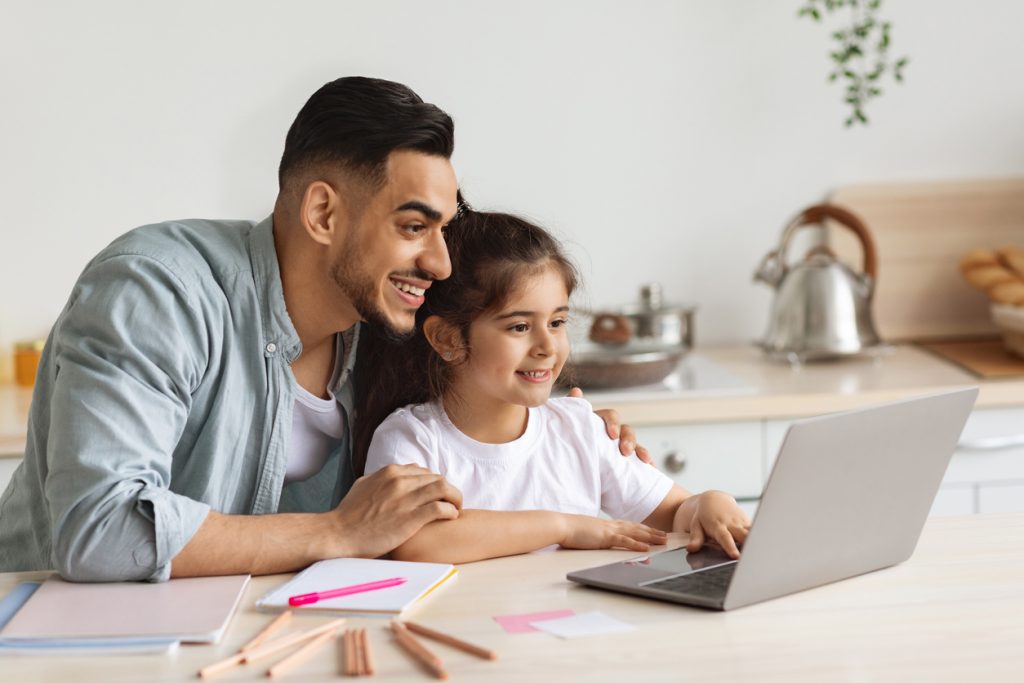
Instead, more and more parents are turning to collaborative online programs like LingoCircle to teach and learn Arabic online for kids.
# Curriculum built by Foreign Language experts and Childhood educators
Not only are the programs adaptable and fluid to the individual, they’re also socially immersive, structured, and integrated with home life. Assignments, activities, and a curriculum built by certified foreign language experts, while a professional instructor conducts the class online with a small handful of other kids.
# Small group format that fosters engagement and a sense of community
The best online language programs for kids understood that learning one on one with a tutor for younger kids won’t create the best engagement. Instead learning with a small group of children sharing similar background will not only help increase engagement, children can also relate to one another. They are happy to meet other children alike. Creating international friendships with children with same family dynamic makes such an impact. They understand why they’re learning the language, they belong to a community.
# Gamification paired with traditional learning experience
In order to create consistency, children need to have fun. The best way for them to learn is for them to not realize they are learning. Learning Arabic online for kids comes with gamification. Curriculum are built around games and themes geared toward what appeals to each age group. It is difficult enough to get children to learn a language they sometime do not speak at home, so having fun and a curriculum built by K-12 education expert is key to making this a successful endeavour.
What ensues is learning on a holistic level; invoking all the senses to retain the material through songs, readings, games, exercises, conversation, and playing together.
These well-rounded programs seem to yield the best results by far. It’s not easy to learn Arabic online for kids – they need to be engaged and having fun, otherwise, they lose focus. Classroom models tend to center blackboards and grammar textbooks rather than play and sensory development. Plus, you don’t want to give up any more of your time with them to some stuffy classroom.
With LingoCircle, you get to enjoy seeing and hearing about their learning journey while still being able to tend to your many other responsibilities. This will help you to help them when the cameras turn off, and you can also find additional support in the online learning group with the other parents taking part.
Your child will become more enriched and motivated every class and you’ll start to see all the possibilities opening up ahead of them and we want to help that vision become more clear. They’ll be able to do so many things that monolingual people won’t get to experience.
How Your Child Will Benefit From Being Bilingual

Learning a language expands the mind and increases the impact of positive impressions within society. In the process of learning a language, the brain begins to stretch and build in really dynamic ways, becoming more:
- Creative
- Adaptable
- Focused/Attentive
- Able to multitask
- Retaining (holding things in memory more efficiently and fighting off Alzheimer’s and Dementia)
- Adept at problem-solving and critical thinking
- Adept at communication and emotional intelligence.
These traits then translate to many other physical and opportunistic benefits. People who grew up learning more than one language test and score better in school, accumulate more nuanced cultural and literary interests & knowledge and are more likely to qualify for scholarships and grants based on linguistics or other byproducts of their curious minds.
Bilingual folks enjoy travelling with ease to a number of countries, connecting with people from other cultures they would never have been able to with a language barrier. Making connections like these significantly alters our worldviews and helps to make us more multifaceted people with balanced perspectives.
Even more, enlightenment opens up for our kids when they get to connect with their personal heritage and mother tongue.
How Your Child Will Benefit from Learning Arabic
Arabic is such a wonderful language, carrying with it context for such a rich and lively community, culture, and spirituality just waiting to be understood in all its complexity. There are so many advantages to learning Arabic online for kids to gain insight into the language – even if it isn’t their background. The more immersed they become, the more they’ll naturally take on the speech patterns, pronunciation, accent, and slang too.
#Financially
The Middle East is seeing an influx in their economy thanks to the abundance of valuable natural resources in the region. With the language in tow, one can leverage many well-paying job prospects in their favor. The demand for English-Arabic speakers is high for positions like research, investment, development, translation, negotiation, military liaisons, international relations, overseas coordination, and general business operations. Less than 1% of US students can speak Arabic as well as English, making these frontiers much less competitive for those who do. Your child will stand out in a market that tends to pay very well.
#Emotionally
Arabic, though not too popular in North America, is still in the top 5 most widely spoken languages on earth, with vast spacial coverage. Over 290 million people speak Arabic worldwide, each becoming a potentially significant person in your child’s life. Imagine all the extra connections and possibilities! Being able to communicate with fellow humans is one of the most rewarding and influential forces we can find, especially those who live differently from us. Who knows, your child’s soul mate or future business partner could be an Arabic speaker.
#Intelligently
Many other languages have Arabic at their center, making it what’s called a bridge language. If your child learns Arabic, they’re already halfway to learning Farsi and considerably closer to knowing Turkish and Hebrew. The foundation is already going to be there, making other language patterns and accents much easier to grasp. Why stop at two?
It’s like a buy 1, get 3 for half-price kind of deal. So many new windows open up for those who have even elementary knowledge of multiple languages. Muscle memory is able to create associations and link connections quickly, helping with remembering new words and phrases, even in a different language. Just like Spanish is easier to learn if you know French, as they’re both Latin-based – Arabic and its adjacent languages are all Semitic style languages, carrying related words and roots throughout. Even unrelated languages carry Arabic influence, like English and French, making it a crucial linguistic centerpiece.
English words that are inspired by Arabic include:
- Alcohol
- Magazine
- Ghoul
- Algebra
- Sofa
- Candy
- Checkmate
- Coffee
- Saffron
- Average
- Cotton
#Culturally
Learning Arabic is about so much more than collecting an extra language; it can become a monumental step in destigmatizing the culture as a whole. When you can understand the words, you can become part of the narrative. Inserting oneself into, or even just listening to, the polarizing discourses surrounding Arabic religion, war, and customs is only productive when you’re exposed to all sides, which means you first must understand the Arabic people and their perspectives.
Your child may not become part of those heavy conversations for a while, but giving them the option will give them the freedom to make informed decisions on where they stand on certain issues without Western bias. A 2010 Gallup poll found that 52% of Arabs in the US had experienced discrimination and xenophobia in the last year. This was higher than any other racial demographic that was polled. Adjacently, less than half (32%) of Americans held favorable views of Arabs and Arabic culture. In a post-9/11 world, Middle Easterners need all the understanding they can get. Set your child up to see the world as it really is; not in black and white.
Through language, they’ll gain insights into the political history, militarization of certain regions, religious beliefs, economy, and traditions of many Arabic-speaking areas. Islam is the second most practiced religion worldwide, though it is largely debated and misrepresented, for better or worse. It is the framework behind many governing bodies and societies, and your child will be able to bridge the gap between Western and Middle Eastern ideologies, forming curated perspectives that ring true to them based on a wide variety of factors and perspectives.
Your child will get to enjoy the staples of Arabic pop culture as well! They’ll enjoy beautiful artists like Amr Diab and Nancy Ajram singing profound lyrics and weaving beautiful stories. They’ll get to experience cinematic phenomenons like West Beirut, Al-Mummia, and Theeb, to name a few. They’ll explore literature classics like One Thousand and One Nights/Arabian Nights, Honor, and, of course, The Qur’an. This exposure will be responsible for their reference points in life, giving them more areas of experience and perceptions to draw from.
Arabic culture holds some of the most ancient and prevalent influences on the world at large. Understanding its history and affluence is key to understanding all other cultures and societies as well. Much of the Western civilization is built on international exchange, immigration, and inspiration from the Middle East.
#Soulfully
Arab speakers are proud of their ancient heritage. When they hear others making the effort to communicate with them in their native tongue, they are automatically disarmed and appreciative. They are happy to show off their language and culture, rewarding anyone trying to learn from them or relate to them. Beautiful friendships and connections can be made from such efforts and rewards.
Your child will grow up to be able to travel to some of the most beautiful Arabic-speaking places on earth, including Egypt, Morocco, Lebanon, and Israel, to name a few. These locations hold rich and haunting histories, delicious food, and breathtaking scenery. Don’t even get us started on the architecture and resilient people.
Arab people are historically some of the most tenacious communities, overcoming harsh conditions like prolonged droughts, elemental exposure, invasion, etc, while remaining tender and gracious. They’re hospitable and kind people, even while under tense governing conditions and oppressive forces. It’s impossible to visit these places and commune with these people without becoming a more whole person.
Who wouldn’t want these things for their children?
You would do anything to help your children and make sure they get the best support and education possible. You can start the journey with LingoCircle to learn Arabic online for kids who deserve a leg up in the world and a rich connection to their heritage. Qualified experts, friendly classmates, and a comprehensive program are what sets us apart from apps and stuffy classrooms! What are you waiting for?
Check out our program to learn Arabic online for kids here!

As we all know, there’s no perfect way to be a parent and there are many different parenting styles to chose from.
Although there are many different techniques that you can come across that could work for your family, today we will be discussing some French parenting techniques. These techniques are considered to be a “non-nonsense” type of parenting style that is full of love and appreciation.
These French parenting techniques may not be the perfect way to raise a child, but it is definitely a parenting style that we can all learn a few things from.
Let your children do difficult things
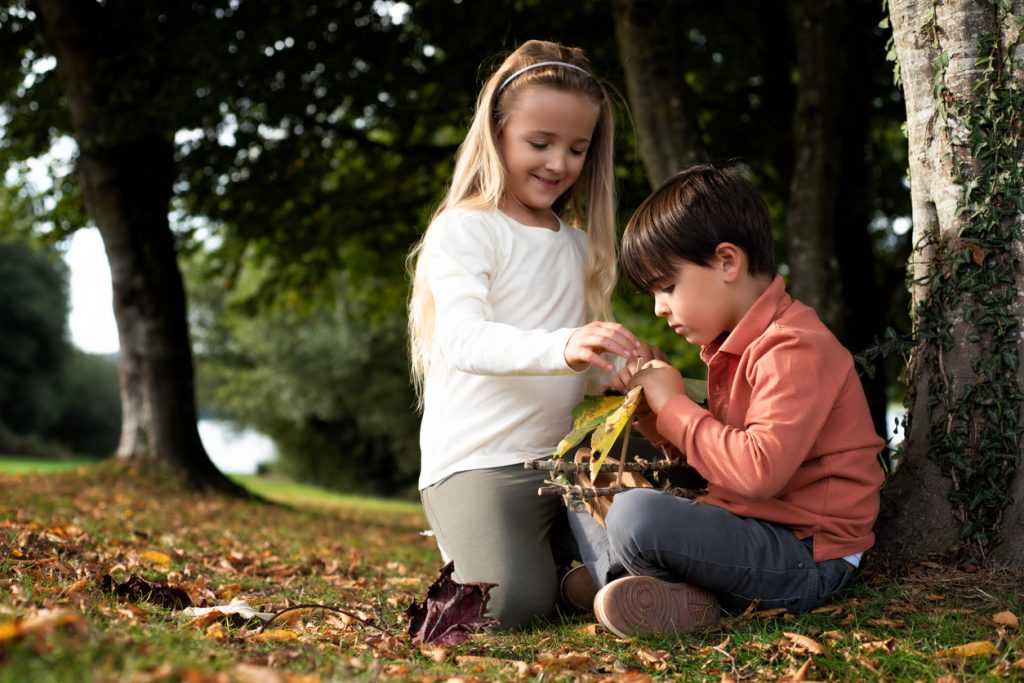
Children love to explore and try new things. One of the best thing that you can let your child do is to let them discover new things on their own (or at least with some parental supervision). In general, French parents focuses a lot on treating children like “adults-in-training” rather than just children who need constant guidance and interference.
According to the American writer, Pamela Druckerman, an American mother who lived in France and noted the differences in parenting styles in her book Bringing up Bébé, the French encourage autonomy. French parenting focuses on letting their children feel confident and capable of doing things for themselves. This concept helps children mature a bit faster as they can practice new things and make mistakes while they are young.
Of course, you can mix a batch of chocolate chip cookies dough much faster than your children – you’ve had a lot of practice. But, if you’re taking over and doing things the faster way, this won’t encourage your children to learn for themselves. Children are capable of learning to do difficult things, but they may need to be shown extra patience.
Teach your children to sleep well from an early age
French babies don’t learn to sleep through the night just by nature – instead, they are taught.
In order for parents to avoid exhaustion, especially as new parents adjusting to their new stage in life with children, they need proper sleep (and so does their baby!). French parents focus on something called “the pause.” The pause is quite literally a pause. When babies cry during their sleep, you need to allow them to pause and let them attempt to self soothe before you rush to the rescue.
All humans have different sleep stages and this is no different for children. When infants are put to sleep, they do not instantly fall into a deep sleep. In fact, they wake up multiple times for very brief moments. Just as you may “wake up” to toss and turn a few times at the beginning of your sleep cycle, infants “wake up” and make noises.
If you allow your infant some space to toss, turn, or make noise in their early sleep cycle, you’re giving them the chance to fall back into a deeper sleep instead of completely disrupting the sleep cycle. By learning to self soothe, children will learn to not depend on pacifiers, hugs and kisses, singing, rocking, and bottles to fall asleep and stay asleep.
Teach them to say “hello”
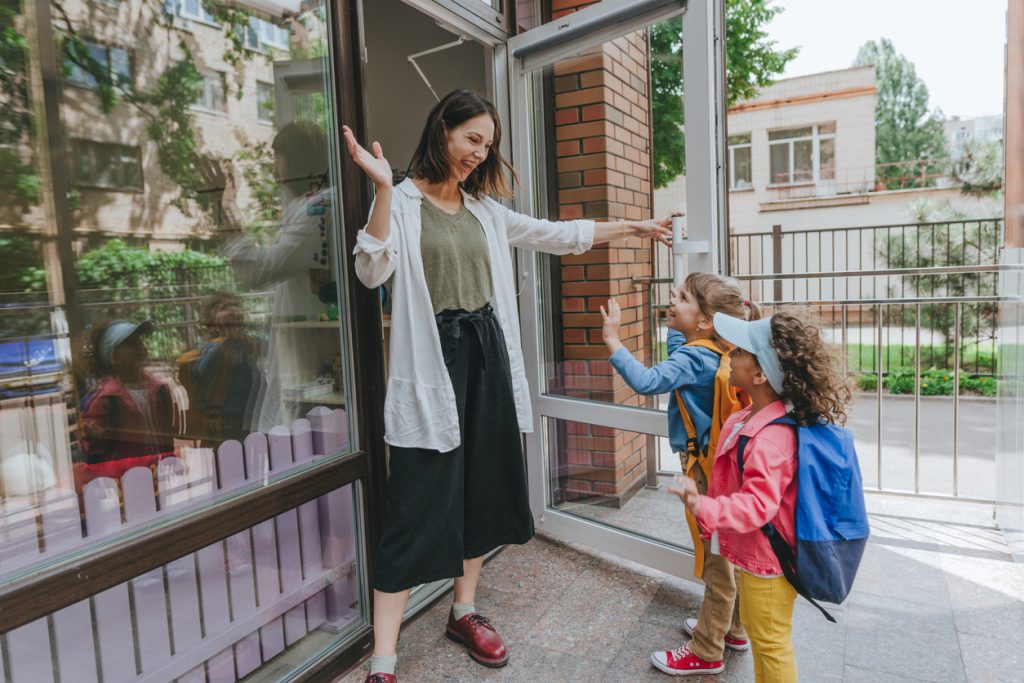
In the French culture, children are not granted a “pass” on saying hello to everyone in the room. Just because they are shy or young does not mean that they are any less of a person. Children are supposed to acknowledge everyone’s existence and say hello to adults, teens, and other children alike. Adults would not get a “pass” on greeting others, so they do not teach children that it’s acceptable to avoid greetings only to unlearn that behavior as they grow.
A polite hello (or bonjour) is a major part of the French culture. In social settings and business settings alike, the lack of a greeting is seen as rude. Even when you enter a shop, it’s very normal to greet the workers with a friendly hello and unfriendly if you stay silent.
Learning these social manners at a young age will benefit children throughout their whole life. This is also a great way for children to develop self-confidence from a young age. A small greeting goes a long way.
Encourage them to be resilient
Children are going to encounter some difficult experiences in life, whether they want to or not. The fact is, some rough experiences are a part of life and the best thing to do in these situations is to learn from them.
French parents understand that although it may be unpleasant, going to the doctor, visiting the dentist, getting flu shots, experiencing failure, etc. are a part of life. In France, you won’t find any doctors or dentists saying “sorry” for the slight discomfort because they want children to understand that they cannot avoid certain things. As children learn to deal with hurt, they grow into stronger and more resilient humans.
In the same sense, failure is an unpleasant experience. However, the French understand that it is going to happen, and you need to let it happen. A failed opportunity is one of the best learning opportunities that any child can have! At the same time, your children will also learn great problem-solving skills.
Feed your children the same thing that the adults are eating.

The French take their food very seriously, and children are no exception to this standard.
French children are expected to eat the same thing that adults are eating. It is not a common practice to find adults cooking their children completely separate meals like pizza, chicken nuggets, or pasta. All members of the family typically eat the same meal and children enjoy their meal in smaller quantities.
Although children may have their preferences of food, they are still expected to eat what everyone else at the table is eating. This includes traditional French dishes that you might think are for a more developed pallet like dried sausages, foie gras, shrimp, tartare, different types of vegetables, and of course cheese.
Structure mealtimes
The French typically don’t have too much trouble with their children not wanting to eat during mealtimes. This is because the French don’t encourage snacking on a regular basis. For children, there is one snack time (le goûter) and 3 meals per day.
This tactic encourages children to wait for their meals and develop a healthy dose of hunger, so they will be able to eat their meals at structured times. This also helps children develop patience and train their stomachs to not be dependent on food to regulate their emotions/moods for instant gratification. Instead of offering snacks to children during a slight inconvenience, French children taught to wait.
Avoid over-praising your children
Americans have earned themselves a notorious reputation for awarding trophies for participation. Despite your opinions on this style of encouragement and parenting, the French have quite a different outlook.
While American parents have a habit of praising their child for the smallest situations, French parents use their praises more sparingly in hopes of not creating an expectation of praise in every situation. When children are praised, they feel a great sense of confidence, pride, and happiness. They will know something that they did is exceptionally good, not just something that is expected of them. French parents like to praise children for doing something unique and extraordinary, instead throwing around praise at every turn.
Maintain your own identity after having children
In the French culture, parents still maintain their interests, dedication to fashion, and friendships after having children. Having children is a blessing and one of the most joyous things on the planet, but becoming a parent doesn’t mean that you have to lose a sense of self identity.
In some cultures, it’s very common for the parents (especially the mothers), to identify themselves only as a parent as if it is their job. Although there is nothing wrong with being a dedicated parent, some parents tend to lose time for themselves, their own interests, and their friends.
The French typically try to maintain their sense of balance in life. They love the part of their life that is being a parent, but they also love to keep up with their personal life, professional life, and goals.
Carve out time for you and your partner
Carve out sometime dedicated to you and your partner. Children learn that the parents are not only around to serve the children at every constant moment, but that they are their own people as well. This technique creates some level of distance between adults and children and shows them the importance of showing undivided attention to your other half.
Some parents are insistent upon spending every moment with their children. However, French parents make sure that they have some separate adult time away from their children. Although this may come along with some guilt of separation, it lessens the chance of burnout and stress when parenting.
Parents have their own interests, their own relationships, and need their time as adults respected and encouraged by their children. This is a very French outlook that also teaches children more independence and to respect other people’s time and boundaries.
Let your “no” mean “no”
Have you ever said “no” to your child and then decided later to change your mind due to some consistent pleading, negotiations, or tantrums? Most likely the answer here is yes. But, in the French culture, parents are much more likely to stand firm in their “no.”
When French parents say no, they mean it. Although this can be very difficult at first, it’s much better to endure tantrums and pleading for a short while instead of dealing with it for multiple years. This teaches children to respect words and instructions from adults, especially their parents and understand that not everything that they want will happen.
Let your yes mean yes, and your no mean no.
Let your child learn from trial and error
Have you ever heard of the term “helicopter” parenting? A helicopter parent is someone who “hovers” over their child (like a helicopter) and is extremely involved in different aspects of their child’s life. While French parents are typically involved and interested in their children’s lives, they are not interested in controlling it.
The French really like to see their children learn things by trial and error. This includes all the simple things in life like letting them make age appropriate decisions about their time, hobbies, and after school activities.
Respect family time
Screen time at dinner? This is something you will never see during a meal with a French family.
The absence of conversation and the presence of texting while eating is not a reality in the French world and not a habit they’re likely to adopt anytime soon. The French tend to encourage family time, especially at the dinner table where they can all have a chance to catch up about their days and have uninterrupted communication.
Encourage playtime

What is the highlight of a child’s day, sitting down in a classroom at school or letting loose during playtime? Playtime, of course!
A long school day seems like almost an eternity to little kids. Sitting still, being quiet, and being in a structured environment for almost 8 hours a day is a lot to ask for.
When it’s playtime, it’s a great idea to encourage your child to go all out and have fun. They are always full of energy and will love to burn it off, run around, and just have fun. The French believe that playtime is a great way to use energy, and at the same time it stimulates the brain and makes it easier to focus during their structured learning time.
French Parenting Style
Now you’ve had an inside look at the typical ways that French families parent. Although there are not “one size fits all” rules for parenting and every family will have their own unique takes on these techniques, this list provides you with the basics.
Interested in learning more about the French culture? Take a look at these few articles to get started:

It’s never too early to introduce a new language to your children, but the task can be incredibly daunting for you and dry for them. How do you keep them engaged while keeping you sane? Where do you start? Luckily there are some tricks that will help them learn Arabic.
Starting Out
The best time to learn a new language is young, right around the time they’re learning their primary language. Children aged 2-15 are like sponges, and the younger they begin, the more retention and fluency they’ll have. Kids learn languages more efficiently than adults for a number of reasons:
- They aren’t scared of failure or embarrassment. For some reason, as we grow, we become more apprehensive about trying new things for fear we may look foolish while getting the hang of it. Kids have no such inhibitions and happen to enjoy looking silly.
- Their lessons are tailored in a more fun and engaging way than the adult curriculum. It’s likely we’d learn almost just as well if we got to sing songs and play immersive games rather than conjugating verbs on blackboards for hours.
- Their brains are creating tons of new neural pathways with lots of elasticity, whereas our pathways are set more rigidly within the confines of the language we’ve become so accustomed to speaking. Their magical stretchy brains allow for adaptation to new grammatical rules, accents, and physiological habits since the pathways aren’t solidifying in any one direction yet.
The underlying trick to get it to stick is consistent routine and fun. Practice practice practice. Now, while absorption rates are higher in children, attention spans are lower. Kids are learning to multitask, but the function is on overdrive as they discover new interesting aspects of the world constantly for the first time. Distractions are abundant and overstimulating, causing them to lose focus on the task at hand. Researchers estimate that a child’s attention span maxes out at roughly 3x their age. For example:
And so on. This means one must curate a curriculum that breaks learning the language into digestible and enticing chunks.
When starting out, try to prioritize teaching common language rather than slang, niche topics, or complex dialogue. Start with what you need most and work outwards. There will be tough moments but patience and praise is key. Remembering your mutual goals and acknowledging how far they’ve progressed will help keep everyone motivated and focused.
Learning Arabic
Being multilingual comes with many advantages in both the external world and the internal cognitive function of the brain. Not only will your child get more job opportunities and test better in school, but they’ll also make more connections with perspectives from around the world and increase their brain power. Being bilingual increases creativity, flexibility, multitasking, memory (holding off things like Alzheimer’s and Dementia), attention, problem-solving, and can become the stepping stone to an easier path in learning a third language.
They’ll enjoy traveling with ease, expanding literary and cultural knowledge, and will generally become better communicators and company. Who wouldn’t want these things for their children?
Most parents who want their children to learn Arabic are first-generation immigrants who want to infuse their culture into their hybrid home. Their children are likely learning English first, and it may feel like they don’t have ties to their roots. Ready to embrace their heritage but often busy trying to raise a family and keep up with work, they may seek out efficient and flexible methods to teach Arabic to their children. Sound like your family dynamic? Here’s where the tricks and tips come in.
Make Learning Arabic Easy for Kids
Kids are still kids at the end of the day, so they’ll only devote attention to something that’s made appealing and immersive to them. Try these tactics when learning Arabic for kids.
Make Songs
Making just about anything into music and rhyme is a surefire way to get it to stick in the brain. “Music activates both the left and right brain at the same time, and the activation of both hemispheres can maximize learning and improve memory”, claims a study done by Florida National University. This will be especially effective for children who adore music and nursery rhymes. The tempo allows for slower pronunciation, the rhymes create associations that trigger a memory response, and the whimsy of it all keeps them interested and focused.
Much like parentese helps babies develop their primary language and intonation, music does the same. The exaggerated vowels, repetition, and varying tempos/pitches keep the shortest of attention spans in babies & kids going. They remain interested in the unpredictability of what will come next (as opposed to the flatter lineation of speech). Repetition, association, and charm for the win.
Leverage Gamification
Kids just want to have fun! Making anything possible into a game, much like a song, will keep them captivated and challenged. Trick them into thinking they’re not learning. Fun language games can be “word of the day” traditions, Arabic role play, and finding cognates (cognates are common root words and meanings between the primary language and the one being learned in order to make associations with our already familiar neural pathways. Arabic-English cognate examples can be found here). Playing word games like Scrabble, Articulate, or crosswords can be a great way to develop that out-of-box thinking they need to step into their learned language.
Get Apps
On that same note, game apps like Words With Friends or language-centred learning apps like Duolingo can be the way to go. Kids love the screens for some reason. This may keep them engaged more than a newspaper crossword or live song – and that’s okay. They’re learning valuable skills while having fun.
Other apps like Memrise, Babbel, and Rosetta Stone, Little Pim, Gus On The Go, to name a few, may be the right format for your child since every kid learns differently. Some will use more visual appeal, while others are more auditory. Some are free, and others have a monthly fee. It’s just about exploring what’s right for your family.
Engage their Senses
Finding out how your child learns best is a great place to start when strategizing your focus exercises. It’s still useful, however, to immerse each of their senses sometimes, regardless of a primary learning style. Language curriculums should be auditory, visual (reading and written), and verbal. Watching movies in Arabic is a great way for your kids to connect body language & mannerisms with words & meaning while observing subtle mouth movements and speech styles. It’ll keep them engaged more than a workbook will as well.
Inserting Arabic stories into the bedtime routine or picking up chapter books with playful plots will prove to be yet another great way, just like with movies, that context clues can help create meaningful associations without having to pick up a dictionary every 2 minutes. The storyline will draw them in, helping their minds fill in the blanks of the words they don’t know. They’ll subconsciously pick up the patterns as words repeat in similar sentence subjects, further validating their imposed meaning with a more specific and accurate one. Don’t underestimate the ability to hone in on nuance, especially with kids, who are extremely receptive.
Immerse Them in the Culture
You’ve heard of eat, pray, love? Try eat, breathe, and sleep the language. The more your children are around fluent speakers, Arabic writing, and Arabic culture, the more they’ll subconsciously pick it up. People are wired to make connections with other humans as efficiently and effectively as possible, mimicking them to provide comfort and relatability. If possible, try travelling to an Arabic-speaking country and spending some time there with the kids. Or, if the older members of your household speak Arabic, speak it more often at home to your kids.
Get Them a Practice Pal
Finding an Arabic pen pal who can also have fluent verbal conversations with your child can be so helpful. Engaging in active conversation is different from formal written formats and will help add a natural native accent and linguistic style to their speech. Find someone who can hold them accountable for their practice, putting to use what they learned that day, so it’s more likely to stick. They’ll then become affluent in useful everyday phrases and questions.
Join a Holistic Program
Do these helpful strategies still sound like more than you, a parent with very limited time and resources, can take on every day? Try enrolling your child in a program that includes all of these fun and effective strategies, like LingoCircle. A holistic approach is going to be the most effective tactic.
The LingoCircle Program
LingoCircle is an online language learning program for kids aged 3-15 that creates a unique classroom experience with a proprietary curriculum built by certified language experts. Your child can learn arabic online with a handful of other kids and a skilled certified native linguistic teacher. They’ll sing songs, play games, learn letters & sounds, do activities, learn math, read books, etc. – all in Arabic. You’ll find yourself in a community of other parents and children wanting to socialize and practice the language together.
Other parents have nothing but great things to say about their LingoCircle experience. One says, “I have tried many language classes for kids, and this is the best! The curriculum is well thought through, the teachers are really engaged, and the classroom experience is unique. My 8-year-old loves it and has made so much progress in only one month. Highly recommend LingoCircle’s bilingual education program!”.
Another client reports, “I am so happy to have found this amazing program! My son enjoys his classes and is engaged and connected with the teachers and his peers. He has learned so much and is progressing so well. The teachers are attentive, energetic and caring”.
The LingoCircle curriculum is consistent with the Arabic Preschool and Elementary School immersion programs for early learners. The certified teachers are very qualified native speakers who are trained in early education. LingoCircle was founded by certified foreign language experts & childhood educators, so they maintain those standards within their curated programming. You’ll get progress reports regularly, so you can see that your child is thriving and committed to the lesson plans.
LingoCircle takes the load off you while providing your child with structure, a routine for learning and ties to their roots. Being bilingual is such an advantage in a world where being an immigrant can still come with many disadvantages. Instilling a second (or third – who’s counting?) language into your kids will open up many opportunities in life for them while enriching their minds and cultural understanding. They’ll appreciate it when they’re older, even if they rebel against it a bit now.
Language rebellion is a totally normal response to the introduction of a new language. Kids may hold onto their primary language in an assertion of their original identity and individualism while trying to fit in with classmates. This often fades as they come to enjoy the freedoms bilingualism brings. This is also the reason why LingoCircle’s program believes in learning with peers and friends sharing similar background and willingness to learn the language. This unique classroom experience triggers interest and engagement in kids that would most likely be more challenging otherwise.
Outside the classes, you can help them by encouraging both languages, highlighting the importance of communication in real-life situations, and remaining patient and open to compromise. This will allow them to feel more agency over their lives and decide on their own to make peace with this new change. Soon it will become another thing that makes them special and dynamic.
Conclusion
Do yourselves both a favor and enroll in LingoCircle now. Your children will thank you later. Qualified experts, friendly classmates, and a comprehensive program are waiting for your family to join in!

Learning a second language as a child can give your kids the best foot forward as they step into their future. There’s no better language to learn as a second language than Spanish. Why is this? That’s what we’re here to tell you.
There are many important reasons to learn Spanish as a child, and we will only go over a few. Wherever you are and whatever the future holds for your child – learning Spanish is important for giving them the best opportunities in life, understanding and growing in their cultural identity, and much more.
Why Is Spanish Important to Learn for Children?
Spanish is one of the most widely spoken languages in the world. In fact, with 548 million speakers, Spanish is ranked as the 4th most commonly spoken language after English, Mandarin Chinese, and Hindi. In terms of only native speakers, Spanish is the second-biggest language. This is thanks to 21 different countries proudly having it as their official language.
If you live in the United States, Spanish is becoming increasingly more popular. Even though it’s not an official language, the United States has the second-highest population of Spanish speakers in the world.
Spanish is becoming more popular every year and will continue to grow from here on out. After seeing some statistics, you’re beginning to understand why it’s important for children to learn Spanish. In the content below, we will gladly guide you through 9 other significant points that show just how important it is for children to learn Spanish.
1. Early Language-Development Skills
A common mistake is waiting until your child is older to begin introducing them to Spanish. The best time for children to learn Spanish is as early as possible. This is because children have an amazing brain capacity for early language development.
Language learning is a unique skill that helps children innately pick up a language by consistent exposure. Words, phrases, and ideas make more sense to them the younger they are. As they are learning to already process one language, their brain’s language development techniques are sharp. Furthermore, the brain is flexible enough to perform these techniques in two languages at the same time.
Think of the brain as a giant muscle. The more you exercise a muscle, the stronger it gets. Exercising one group of muscles can also have a positive impact on other muscle groups of the body at the same rate. This same principle applies to your brain. The more that this muscle is “trained,” the better it will perform overall. By heavily exercising the language development part of the brain right away, the brain can also be stimulated in other areas. Other skills like communication, memory, concentration, curiosity, and creativity are greatly influenced by language development.
2. Multi-Cultural Diversity
Learning a second language is more than just learning how to speak, listen, read, and write. Language learning is all the more fun when culture is involved. While learning Spanish, there are many opportunities to learn about different cultures and become more culturally diverse! Although there are 21 countries that share Spanish as a common language, they all have their own unique characteristics that are worth learning about.
Fútbol (soccer), dance, art, food, family, celebrations, and history are all very important overarching topics to learn about in each Spanish-speaking region. Here are a few vibrant examples of culture from different Spanish-speaking countries that can be enjoyed while learning:
- Fútbol: The World Cup, Messi’s legendary skills, Real Madrid and Barcelona’s Rivalry, and La Copa Libertatodores
- Dance: Spanish Flamenco, Cuban Salsa, and Argentinian Tango
- Food: Spicy Mexican Salsa, Spanish tapas and paellas, Latin American Empanadas, and the history of chocolate (cacao)
- Family: family structure and dynamics in different cultures
- Celebrations: The day of the dead, quinceañeras, independence days, and traditions for common holidays
- Influential People: Simón Bolívar, Bartolomé de las Casas, and the Pope Francis
- Art and Music: Salvador Dalí, Selena Quintanilla, Pablo Picasso, and Shakira
- Indigenous Culture: Mayans and Aztecs, Quechua, Pyramids in Mexico, Spanish Conquistadors
This list just breaks the surface level of all the rich culture that there is to discover about people and history from all different cultures. Learning about culture can be a very immersive and enjoyable way to enhance learning a second language! By looking into different countries, your child will definitely become very well-versed in different cultures and learn how to appreciate them.
3. Career Placement
Being fluent in another language gives you a big competitive advantage in the job field. Although this isn’t an immediate concern for young children, they’ll be grateful that their parents understood the importance of teaching them Spanish at a young age.
The ability to be able to perform a job in two languages equally will double their chances in the future of finding a career and having stability. Especially if they decide to work in an international company, live near a community of Spanish speakers, or work with clients from other countries– they will be glad to have an open door to communicate with more people!
4. Travel Opportunities
As Spanish is spoken in 21 different countries as an official language, speaking this language even at a moderate level can be very advantageous when traveling.
Traveling is much easier and stress-free if you speak the local language enough to order food, ask for directions, and even communicate with the locals. Talking to locals and reading information of things to do for the habitants of that country can give you the inside scoop to make your trip more memorable and unique. Not only is traveling great for connecting with other Spanish speakers, this will also expose you to different accents and phrases that are used in different countries.
From the Galapagos Islands in Ecuador, to Machu Picchu in Peru, to the beautiful beaches of Spain– there are many beautiful places to visit in each and every Spanish-speaking country. They are all worthy of a trip! The ease of traveling is yet another great reason to learn Spanish.
5. Other Language Learning Becomes Easier
Spanish originates from the roots of the Latin language. This means that other Latin based languages will be much easier to learn based on sentence structure, grammar, syntax, common alphabet, and vocabulary. French, Italian, Portuguese, and Romanian originally come from Latin roots. Having knowledge of Spanish makes these languages simpler to pick up on because you will already have the basic concept of the root language grasped.
Learning an additional language in the future will also help your child really understand and strength a language that is already in your repertoire. You never know what other languages will interest your child as they grow, and this will help give them a better chance to quickly become fluent in third language (or multiple!).
6. Spanish resources are easy to find
As Spanish is a widely spoken language, there are a lot of useful resources to help make learning fun.
Thanks to the wide use of the internet and globalization of technology, there are a lot of resources like movies, TV shows, books, and even language classes available for you and your child.
With all the resources, it may even be a bit too overwhelming to find the best resources for your child to enjoy learning. For starters, here is a list of some great Spanish resources:
- 7 of the Best Spanish Movies for Kids [+Where to Watch Online]
- 12 Entertaining TV Shows in Spanish for Kids [+Where to Watch Online]
- Language learning apps, volunteer programs, activities and more!
- Fun and Age Appropriate Spanish Children’s Books for 3-12 Year Olds
- Online Spanish Classes for Kids and Teens
Imagine having the opportunity to find interests in double the amount of books, double the amount of singers, and double the amount of movies! By teaching your child’s a second language, they can enjoy another world of humor, movies, jokes, and stories.
7. Bilingual Children Perform Better in School
Another important reason to learn Spanish is a child is the improved learning capacity. Learning a second language develops the brain in a more efficient way because it is trained to work differently. Some studies suggest that taking languages classes increases the brain’s capacity to pay attention, memorize things quickly, and focus on details. These skills learned subconsciously help the overall brain productivity increase. Imagine your child only needed to look over information once or twice to commit it to memory instead of needing to stay up for hours at a time cramming for a test. This is really going to prepare them for their future and save them time and optimize their time overall learning!
8. Connects them to their origin and ancestors’ culture
If you or anyone in your family has roots tying them to Central America, South America, or Spain, your child will have a deeper connection to these origins by learning the language. A language is not only just words and sounds, but it also conveys an entire culture while it’s being used.
The relationship between language and culture is so intertwined, it’s highly complex to separate them. This is why some phrases, idioms, and cultural concepts don’t even exist in some languages and word for word translations don’t always work out. For example, you cannot word for word translate “Do you like it?” in from English to Spanish, because the literal translation is “Is it pleasing to you?” (AKA ¿te gusta?). This is just a simple example proving this point, but there are many more complex ideas and concepts that do not translate word for word based on cultural differences.
An example of a concept is the level of respect and way of showing it. In Spanish, you have two different conjugations for all verbs and subjects that are used to convey a certain level of respect and distance yourself from the other person. Although you can show a great deal of respect in English by using “ma’am” and “sir” while speaking, it’s quite different to use different verb conjugations to convey this concept. By learning the language, you will subconsciously also pick up on the culture.
It’s important to be proud of your roots and where your family came from – learning Spanish is key to making this happen for your child.
9. Connect with other communities and make new friends
If your children learn to speak Spanish inside the United States, they will be able to communicate with over 41 million Spanish-speakers– that’s a big community! This creates a lot of opportunities for your children to build friendships in Spanish, join the local soccer team, play with other children at the park, and be ready for encounters with other Spanish speakers all over town. Creating lasting friendships and building a strong community are great reasons to learn Spanish as a child.
How to Get Your Child Started Speaking Spanish?
If you are living in a country where Spanish is not the native language, it may get a bit difficult to stick to learning. In addition to at home conversations with just parents, sometimes kids need an extra jump start to really dive into their learning.
By enrolling in online classes for your child (ages 3-15), you have the convenience of a class based on your schedule and the comfort of knowing that your child is receiving lessons from a professional. The best part? Group classes are fun! LingoCircle offers your child a great program to help them become bilingual Spanish speakers and have a blast while doing it.

Reading books is a great way for bilingual children to let their imagination run free and build a vocabulary at the same time.
Bilingual children have the advantage of learning words and phrases in two languages, getting familiar with two different cultures, hearing many new sounds, and being able to enjoy the same story twice. While story time alone won’t provide your child with enough language exposure to become fluent, it will surely add new words to their vocabulary and new sounds to their repertoire.
Spanish and English bilingual books are the most readily available, bilingual books on the market. Because both languages need to fit inside the same book, there are two different writing styles that you should be aware of. If you have a preference of bilingual writing style, be sure to select your child’s books accordingly.
Some bilingual children’s books offer side by side language comparisons, while other books mix the two languages at the same time. Depending on your child’s level of fluency and ability to distinguish two languages, you can take two approaches to reading the books with side by side translations.
If your child may need a little more help recognizing the difference between two languages and separating meaning, the best approach is to read the book once through in one language and read it through a second time in the other. This will help create a consistent thought pattern inside their brains to help them develop complete ideas without code switching languages mid-thought. If your bilingual child can already clearly distinguish the difference between their two languages, a fun activity would be reading the side by side comparisons of each translation to look for some differences in the flow of speech and word choice for describing the same scene.
Whether they are reading alongside you or listening to the content orally and looking at the pictures, this will be a critical step in their language development.
We’ve compiled a list of some of our favorite bilingual books for kids that we know your bilingual children will love. Take a look below and let your child chose the bilingual book that interests them the most.
1. ¡Te amo, te abrazo, leo contigo! / Love You, Hug You, Read to You! by Tish Rabe
What are the three best things that children can hear from their parents? “I will always love you, hug you and read to you.” This bilingual book for kids encourages interaction while reading by including short questions for your child. One of the best ways to help children improve their comprehension level is to ask them questions along the way. Thankfully, Tish Rabe is fully aware of this and provides an all around great story book to enhance your child’s reading and language comprehension!
Ages: 0 – 3
Buy it here: Amazon
2. Huggy Kissy / Abrazos y besitos by Leslie Patricelli
Grab this books and snuggle up with your child and the rest of your family to dive into a sweet and fun story about showing love. What’s not to love with this bilingual board book? Leslie Patricelli creates an irresistibly affectionate Spanish-English book that your little will be sure to enjoy.
Ages: 0 – 3
Buy it here: Amazon
3. Vamos a jugar (Let’s Play, Spanish-English Bilingual Edition) by Leo Lionni
Let’s Play/ Vamos a Jugar is a great board book introduces your child to familiar words used for play time in both English and Spanish. Follow along as Leo Lionnni tells the tale of two mice who learn to play together and find some fun things to do!
Ages: 0 – 3
Buy it here: Amazon
4. The Very Hungry Caterpillar / La oruga muy hambrienta by Eric Carle
This classic is available in side by side English and Spanish. Thanks to Eric Carle, you and your little one can enjoy the light-hearted short story of a very hungry caterpillar and see what is on the menu!
Ages: 2 – 5
Buy it here: Amazon
5. Cerca / Close by Juan Felipe Herrera
As two companions begin to notice the world around them, they begin to realize what is close / cerca and what is far / lejos. Juan Felipe Herrera writes an engaging story of children’s observations in a simplistic, colorful, and charming way.
Ages: 2 – 5
Buy it here: Amazon
6. The Day of the Dead / El Día de los Muertos by Bob Barner
Bob Barner introduces a cheerful and important cultural holiday in multiple Spanish-speaking countries – The Day of the Dead! This book allows you to tag along as two children learn all about the preparation to greet their ancestors and to celebrate their lifetime with their close family members.
Ages: 2 – 5
Buy it here: Amazon
7. Señorita Mariposa by Ben Gundersheimer (Mister G)
In this rhyming bilingual children’s book you can have a front row seat to follow the fantastic migration journey that monarch butterflies make each year from Canada to Mexico. This child-friendly book filled with bright colors and vibrant illustrations is the perfect for you and your little one to activate your imaginations to travel across countries without leaving your own home.
Ages: 3 – 5
Buy it here: Amazon
8. The Feelings Book / El libro de los sentimientos by Todd Parr
This bilingual book for kids is a true treasure for kids and parents alike. Todd Parr gives children and parents a go-to picture book specially written to help little ones describe their feelings in both English and Spanish. Not only is this a great read full of bright colors, it’s a great resource for building emotional-intelligence and creating a strong vocabulary at a young age!
Ages: 3 – 6
Buy it here: Amazon
9. The Cat in the Hat Beginner Book Dictionary in Spanish by P.D. Eastman
Who doesn’t love a classic doctor Seuss story? Thanks to P.D. Eastman, you and your child can enjoy a colorful picture book filled with eye catching, short sentences in English and Spanish. Each main word is enhanced with a visual representation on the page and is accompanied by a translation. Looking for even more? This book includes a free dictionary that acts as a pronunciation guide to help in oral language production.
Ages: 3 – 7
Buy it here: Amazon
10. La Princesa and the Pea by Susan Middleton Elya
This rhyming bilingual children’s book put a fun twist on a cherished classic. You and your little one are sure to be enchanted by these Peruvian inspired illustrations as you set out on an adventure with a beloved príncipe who chooses to follow his heart and go after his perfect match.
Ages: 4 – 8
Buy it here: Amazon
11. Sing With Me / Canta conmigo by Jose-Luis Orozco
Looking for some songs to sing? Look no further and get your hands on this beautifully illustrated, bilingual song book filled with six delightful songs that you and your little one are sure to love. Practice your singing skills in English and Spanish with side by side translations– now you’ll have double the songs to sing!
Ages: 4 – 8
Buy it here: Amazon
12. We Laugh Alike / Juntos nos reímos by Carmen T. Bernier-Grand
Carmen T. Barnier-Grand tells a common story of two young friend groups who want to play together even though they don’t speak the same language. This bilingual book trades back and forth between English and Spanish within the same conversation, so both groups of children are equally understood. See how these children can surpass their language barrier to still have loads of fun!
Ages: 5 – 8
Buy it here: Amazon
13. Quinito’s Neighborhood / El Vecindario de Quinito by Ina Cumpiano
Take a stroll down Quinitos Neighborhood and discover vibrant illustrations of charming buildings, colorful shops, and all the beautiful people that Quinito knows and loves. You and your little one will take a great adventure with Quinito and learn all about his family and their different jobs that make the community thrive.
Ages: 5 – 8
Buy it here: Amazon
14. Isabel and Her Colores Go to School (English and Spanish Edition) by Alexandra Alessandri
It’s time to set off on an adventure with Isabel – her first day at a new school! Some kids get very excited and others, like Isabel, are very nervous for their first day – why is that, you ask? Isabel doesn’t speak English quite yet, but wants to make new friends. Follow along as Isabel tries her best to break this language barrier and creates her own means of communication through her artwork.
Ages: 5 – 8
Buy it here: Amazon
15. Bilingual Fairy Tales in Spanish and English: A Story Collection by Charles Perrault, James Planché, and Teodoro Baró y Sureda
This fairy tale book is perfect for bilingual children of all ages. With a collection of classic stories in English and Spanish, this modernized book complete with a free audio download is sure to become your child’s favorite!
Ages: All
Buy it here: Amazon
Why Bilingual Books for Kids are Key to Bilingual Proficiency
Bilingual children of all ages are sponges for new information. By reading these bilingual books at your next story time with your little one, their language level is sure to improve in both Spanish and English at the same time.
Stories are one of the best ways for children to have new experiences and understand unique concepts without having to experience things for themselves. The constant exposure to new words and imaginative journeys will help them become very well-rounded and versed in multiple subjects.
Whether you are a native English speaker looking for bilingual books in Spanish or a Spanish native speaker looking for bilingual books in English, these stories will be a great place to start.

Hundreds of advice columns, blogs, and best-selling books are available for the best parenting advice, tips and tricks for raising children, different parenting styles, and so on. However, there seems to be fewer resources available for parents raising children bilingually.
Raising children bilingually is one of the most important things that you can do for your child.
Although there are a few different approaches to raising bilingual children like the One Parent One Language (OPOL) method, the Minority Language At Home (MLAH) approach, and others, here are a few all-encompassing “dos and don’ts” for all bilingual parenting styles.
1. Do introduce a new language as early as possible
Children are the most adept to learn a new language the younger they are. Learning a language has to do with exposure time.
The more time that they have to be surrounded by a language – the quicker they will learn. Some argue that more developed brains, for example, teenagers and adults, will be more capable of understanding a language, grammar rules, and speech patterns. However, the most natural way to learn a language is to learn like a child.
In fact, children that are exposed to languages at a young age will have a more native accent and fluent way of speaking than an adult learner. This is because children develop an “ear” by distinguishing meaning from very discrete sounds that they hear for the first time. Young children subconsciously pay very close attention to movements and mimic mouth movement patterns for sounds and syllables from adults. These actions create muscle memory for their linguistic development that ultimately helps them achieve the native pronunciation. The sooner you can introduce a language to a child, the better.
Don’t be afraid to teach them a language even if it’s just your second language
If you speak a second language and want to pass it down to your children, don’t be worried if it isn’t your native language. Many parents have a fear that their level of fluency isn’t “good enough” for teaching their children simply because it may not be their first language.
However, passing down a language is one of the greatest gifts you can give to your child, even if it is not your native language. The exposure will be great for their development, even if you do make occasional mistakes. As a plus, you will learn with them and create a strong bond by sharing a language
2. Do pay attention to the amount of exposure
Exposure is critical to learning a new language for anyone. Exposure helps a language learner understand the correct pronunciation of words, grammar, the structure of phrases, vocabulary, speech patterns, and intonations.
Naturally, this seems like common sense. However, it is “easier said than done.” The more exposure that children have to a language, the faster they will be able to start speaking.
Don’t be frustrated if they start speaking later than monolingual children
Bilingual children typically start speaking later than monolingual children.
Why is this? Monolingual children are only being exposed to one language and therefore only need to make sense of one alphabet, one set of phonetic sounds, one language of vocabulary, and one set of grammar rules. Although this information is a lot for a child to process in itself, imagine double.
Bilingual children are being presented with a high volume of information, but their brains are not overloaded in any sense. Due to the volume of new information, bilingual children need extra internal processing time before they start producing sounds, words, and phrases externally.
Although they may take longer to speak than the average monolingual child, when they do start to speak, they have a lot to say!
Do talk, read, sing, and play in the target language
Make language learning fun! Language exposure doesn’t have to only be about structured learning, grammar rules, etc.
Take a look at your child’s interests and see what they respond to best. Is your child musical? Time to take a look at nursery rhymes, fun songs, and the classics in their target language. Is your child a bookworm? There are a ton of resources online for finding short stories in your child’s target language as well as longer books. After reading together, encourage your child to create their own story to read to you.
Music, books, and playing pretend makes a lot of room for new vocabulary and fun memories. Have as much fun as you can!
Don’t stick to only one way of exposure
If your chosen method of exposure isn’t working out well with your child, don’t be afraid to try something new. This could mean looking into social groups, traveling to native speaking countries, volunteering around your town, listening to the radio, or finding pen pals!
4. Do correct your child positively if they make mistakes

Children are going to make mistakes and that is a very natural part of learning a language.
Let’s take English for an example. Have you ever heard a kid say “look how fast I runnned?” Or “I eated a banana for breakfast.” If you’ve been around young children, chances are you have heard these mistakes once or twice.
This is because children understand unspoken grammar rules by recognizing patterns. Many verbs used in the past tense in English end in “-ed” so it’s only natural that they apply this structure to all verbs. However, when children make mistakes (in English or in another language) it’s important to correct them positively.
There is no need to laugh or make fun of a child for making an error, because they simply do not know and have not yet been taught to speak properly. To correct your child, allow them to finish their phrase without interrupting them (unless they pause for help) and correct them after. It’s important that they learn to speak correctly, but if they are struggling to speak, it’s even more important that they feel comfortable and confident speaking even if they do make mistakes. This is why a positive correct and encouragement make all the difference.
Don’t be worried if they mix languages together while they are younger
Remember how we mentioned that bilingual children have double the amount of information to process? At the beginning of their language development, they may try mixing languages to communicate their thoughts and ideas. This is especially common if both parents (or other family members) understand both languages. If everyone understands French and English, why chose just one language in one sentence? This is how children think, anyway.
If children haven’t yet met a person who only speak one language instead of two, they will have a more difficult time sorting out the languages in the future. Therefore, it’s important to encourage your child to stick to one language for one sentence.
The more practice they have and guidelines they receive, the easier it will be for them to sort out the two languages. However, this shouldn’t be too concerning as it’s something that they’ll naturally grow out of.
5. Do find outside resources
The quality of language exposure is just as important as the quantity.
If your bilingual child is in a monolingual school, consider finding a tutor, online classes, or face-to-face courses to help them learn in a more structured environment from a professional. Although this may not be the best idea of exposure for kids under the age of 3, a child, a young adult, or teen will benefit from professional learning. If you think about it, why do we send children to school? To learn! So why not have classes available to them in both of the languages? This is a great way for them to strengthen both of their language levels.
If you’re looking for an online group or individual class for your child aged 3-15 be sure to check out LingoCircle for classes taught by professionals offering a quality learning atmosphere and fun all at the same time.
Don’t be frustrated if they seem to avoid speaking the language
This phenomenon is called “bilingual rebellion.” If your child suddenly refuses to speak a second language to you, this shouldn’t be a cause for concern. This is common with the minority language when children start school. Children want to “fit in” at all times and may notice that none of their classmates speak a second language.
Don’t take this personally, as your child is not rejecting your culture or language – they are only trying to figure out their own identity. This rebellion may only be a short period of time, but nonetheless it requires a lot of patience. Try your best not to be frustrated around your child if they are speaking the minority language less.
Encourage them with fun activities, movies, talking to relatives, and maybe even traveling! Be strong in your culture and show your child that bilingualism is something to be proud of and an advantage that will serve them well throughout their entire life.
6. Embrace both cultures equally
Language is not only a tool for communication. It is a cultural identity.
Allow your child the space that they need to explore both languages and cultures. Talk about the importance of customs, symbols, food, values, holidays, lifestyles in other countries, differences in dialects, and much more!
With bilingual children, it should be difficult for the child to say only one language is their native language because in reality, both of them are! Language A is no more important than language B. The same goes for their cultures. Being proud of both cultures relating to their languages is a great deal of importance for developing their confidence and their identities.
Don’t compare them to other children
Some children learn faster than others. “Sally speaks better than Tommy. Tommy has a better accent than Sally. Sally can already read in both languages but Tommy—” you get the point.
It’s very hard not to compare your child to others when learning two languages at once because you want to be sure that your child is on track. But, it’s important to realize that all children learn at different paces. One child may excel in speaking, while another may have an immense vocabulary for their age. The combinations of strengths and weaknesses are endless, but the important thing is that they are improving in both languages daily.
Consistency is key for improvement. If your child is struggling in one area, for example reading, consider directing more attention into reading together to help them improve. The only person that you should be comparing them to is themselves.
7. Do find a community of native speakers
As mentioned before, bilingualism is part of you and your child’s identity. As they will want to “fit in” in school by speaking the majority language, it’s also important for them to have a community that speaks the minority language. Knowing more people outside their own home that speak multiple languages should encourage them to speak more.
The immersion of the language in a new setting will also allow them to enhance their language abilities and their social skills at the same time. If your children have friends that speak the same languages, they will subconsciously want to develop their language skills to continue their relationships.
Don’t keep the language isolated inside the family
In the same manner, it’s great to show your child that your second language exists and thrives in other places outside the home. Whether this is talking with other family members, community groups, friends, pen pals, or traveling to a country that speaks the minority language, your child can see that this language is a vital way to communicate instead of just viewing it as an optional way to communicate in their own home.
Conclusion
Bilingual parenting is one of the best decision you can make. Although it may be tough at first, it’s worth it in the long run. Bilingual children have many advantages in life and will thank you for all the hard effort and long hours of consistency that you’ve put in to help them become bilingual.

Halloween is around the corner, it’s pumpkins, witches, ghost and werewolf seasons and there’s nothing best for kids to learn than to use their favorite themes. Download these 2 French Halloween vocabulary worksheets and have fun with your child while learning French.

#1 Vocabulary and Visual recognition
Instructions: find the words in the grid
Print out this activity sheet for your next dinner or lunch at a restaurant with your kids or for an after-school activity! Have fun with your little one all while learning new vocabulary around the Halloween theme!
#2 A game of Magic
Find the word in the picture and spell it correctly.
Une Sorcière, un magicien…. Have fun guessing the words with the exact letter count associated to each picture. This activity revisits the well know hangman game, le Pendu in French. You can also play the original game at home by drawing a picture and asking your kids to guess the words in French. Fun times ahead!


Simple Ways to Learn a Second Language at Home
Get resources and tips to help supplement your bilingual education journey at home.
By providing your email you are signing up to receive emails from Bilingual Bebe. Privacy Policy
